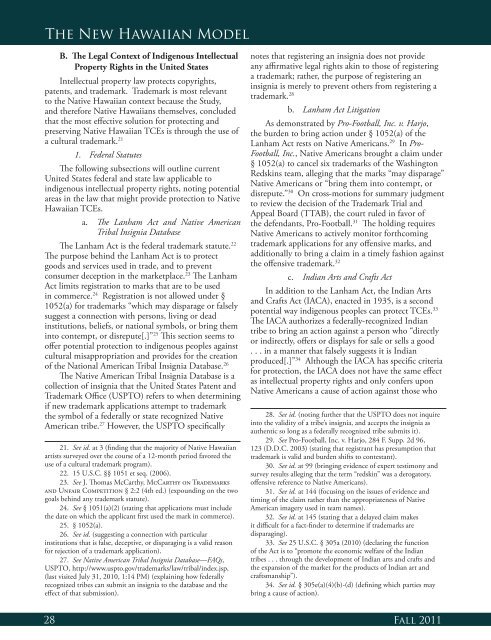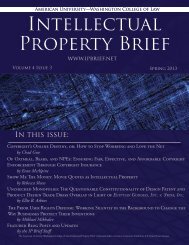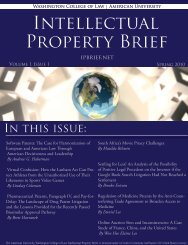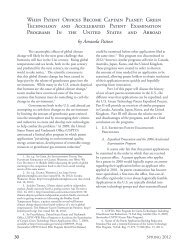The New Hawaiian Model: The Native Hawaiian Cultural Trademark ...
The New Hawaiian Model: The Native Hawaiian Cultural Trademark ...
The New Hawaiian Model: The Native Hawaiian Cultural Trademark ...
You also want an ePaper? Increase the reach of your titles
YUMPU automatically turns print PDFs into web optimized ePapers that Google loves.
<strong>The</strong> <strong>New</strong> <strong>Hawaiian</strong> <strong>Model</strong><br />
B. <strong>The</strong> Legal Context of Indigenous Intellectual<br />
Property Rights in the United States<br />
Intellectual property law protects copyrights,<br />
patents, and trademark. <strong>Trademark</strong> is most relevant<br />
to the <strong>Native</strong> <strong>Hawaiian</strong> context because the Study,<br />
and therefore <strong>Native</strong> <strong>Hawaiian</strong>s themselves, concluded<br />
that the most effective solution for protecting and<br />
preserving <strong>Native</strong> <strong>Hawaiian</strong> TCEs is through the use of<br />
a cultural trademark. 21<br />
1. Federal Statutes<br />
<strong>The</strong> following subsections will outline current<br />
United States federal and state law applicable to<br />
indigenous intellectual property rights, noting potential<br />
areas in the law that might provide protection to <strong>Native</strong><br />
<strong>Hawaiian</strong> TCEs.<br />
a. <strong>The</strong> Lanham Act and <strong>Native</strong> American<br />
Tribal Insignia Database<br />
<strong>The</strong> Lanham Act is the federal trademark statute. 22<br />
<strong>The</strong> purpose behind the Lanham Act is to protect<br />
goods and services used in trade, and to prevent<br />
consumer deception in the marketplace. 23 <strong>The</strong> Lanham<br />
Act limits registration to marks that are to be used<br />
in commerce. 24 Registration is not allowed under §<br />
1052(a) for trademarks “which may disparage or falsely<br />
suggest a connection with persons, living or dead<br />
institutions, beliefs, or national symbols, or bring them<br />
into contempt, or disrepute[.]” 25 This section seems to<br />
offer potential protection to indigenous peoples against<br />
cultural misappropriation and provides for the creation<br />
of the National American Tribal Insignia Database. 26<br />
<strong>The</strong> <strong>Native</strong> American Tribal Insignia Database is a<br />
collection of insignia that the United States Patent and<br />
<strong>Trademark</strong> Office (USPTO) refers to when determining<br />
if new trademark applications attempt to trademark<br />
the symbol of a federally or state recognized <strong>Native</strong><br />
American tribe. 27 However, the USPTO specifically<br />
21. See id. at 3 (finding that the majority of <strong>Native</strong> <strong>Hawaiian</strong><br />
artists surveyed over the course of a 12-month period favored the<br />
use of a cultural trademark program).<br />
22. 15 U.S.C. §§ 1051 et seq. (2006).<br />
23. See J. Thomas McCarthy, McCarthy on <strong>Trademark</strong>s<br />
and Unfair Competition § 2:2 (4th ed.) (expounding on the two<br />
goals behind any trademark statute).<br />
24. See § 1051(a)(2) (stating that applications must include<br />
the date on which the applicant first used the mark in commerce).<br />
25. § 1052(a).<br />
26. See id. (suggesting a connection with particular<br />
institutions that is false, deceptive, or disparaging is a valid reason<br />
for rejection of a trademark application).<br />
27. See <strong>Native</strong> American Tribal Insignia Database—FAQs,<br />
USPTO, http://www.uspto.gov/trademarks/law/tribal/index.jsp,<br />
(last visited July 31, 2010, 1:14 PM) (explaining how federally<br />
recognized tribes can submit an insignia to the database and the<br />
effect of that submission).<br />
notes that registering an insignia does not provide<br />
any affirmative legal rights akin to those of registering<br />
a trademark; rather, the purpose of registering an<br />
insignia is merely to prevent others from registering a<br />
trademark. 28<br />
b. Lanham Act Litigation<br />
As demonstrated by Pro-Football, Inc. v. Harjo,<br />
the burden to bring action under § 1052(a) of the<br />
Lanham Act rests on <strong>Native</strong> Americans. 29 In Pro-<br />
Football, Inc., <strong>Native</strong> Americans brought a claim under<br />
§ 1052(a) to cancel six trademarks of the Washington<br />
Redskins team, alleging that the marks “may disparage”<br />
<strong>Native</strong> Americans or “bring them into contempt, or<br />
disrepute.” 30 On cross-motions for summary judgment<br />
to review the decision of the <strong>Trademark</strong> Trial and<br />
Appeal Board (TTAB), the court ruled in favor of<br />
the defendants, Pro-Football. 31 <strong>The</strong> holding requires<br />
<strong>Native</strong> Americans to actively monitor forthcoming<br />
trademark applications for any offensive marks, and<br />
additionally to bring a claim in a timely fashion against<br />
the offensive trademark. 32<br />
c. Indian Arts and Crafts Act<br />
In addition to the Lanham Act, the Indian Arts<br />
and Crafts Act (IACA), enacted in 1935, is a second<br />
potential way indigenous peoples can protect TCEs. 33<br />
<strong>The</strong> IACA authorizes a federally-recognized Indian<br />
tribe to bring an action against a person who “directly<br />
or indirectly, offers or displays for sale or sells a good<br />
. . . in a manner that falsely suggests it is Indian<br />
produced[.]” 34 Although the IACA has specific criteria<br />
for protection, the IACA does not have the same effect<br />
as intellectual property rights and only confers upon<br />
<strong>Native</strong> Americans a cause of action against those who<br />
28. See id. (noting further that the USPTO does not inquire<br />
into the validity of a tribe’s insignia, and accepts the insignia as<br />
authentic so long as a federally recognized tribe submits it).<br />
29. See Pro-Football, Inc. v. Harjo, 284 F. Supp. 2d 96,<br />
123 (D.D.C. 2003) (stating that registrant has presumption that<br />
trademark is valid and burden shifts to contestant).<br />
30. See id. at 99 (bringing evidence of expert testimony and<br />
survey results alleging that the term “redskin” was a derogatory,<br />
offensive reference to <strong>Native</strong> Americans).<br />
31. See id. at 144 (focusing on the issues of evidence and<br />
timing of the claim rather than the appropriateness of <strong>Native</strong><br />
American imagery used in team names).<br />
32. See id. at 145 (stating that a delayed claim makes<br />
it difficult for a fact-finder to determine if trademarks are<br />
disparaging).<br />
33. See 25 U.S.C. § 305a (2010) (declaring the function<br />
of the Act is to “promote the economic welfare of the Indian<br />
tribes . . . through the development of Indian arts and crafts and<br />
the expansion of the market for the products of Indian art and<br />
craftsmanship”).<br />
34. See id. § 305e(a)(4)(b)-(d) (defining which parties may<br />
bring a cause of action).<br />
28 Fall 2011








